Inside\Within is a constantly updating web archive devoted to physically exploring the creative spaces of Chicago's emerging and established artists.
Support for this project was provided by The Propeller Fund, a joint administrated grant from Threewalls and Gallery 400 at The University of Illinois at Chicago.

Search using the field below:
Or display posts from these tags:
3D printing 3D scanning 65 Grand 7/3 Split 8550 Ohio 96 ACRES A+D Gallery ACRE animation Art Institute of Chicago Arts Incubator Arts of Life audio blogging Brain Frame CAKE Carrie Secrist Gallery casting ceramics Chicago Artist Writers Chicago Artists Coalition Chicago Cultural Center Cleve Carney Art Gallery Clutch Gallery Cobalt Studio Coco River Fudge Street collage collection Columbia College Chicago Comfort Station comics conceptual art Contemporary Art Daily Corbett vs. Dempsey Creative Capital DCASE DePaul University design Devening Projects digital art Dock 6 Document drawing Duke University dye Elmhurst Art Museum EXPO Chicago Faber&Faber fashion fiber Field Museum film found objects GIF Graham Foundation graphic design Harold Washington College Hatch Hyde Park Art Center illustration Image File Press Imagists Important Projects ink installation International Museum of Surgical Science Iran Jane-Addams Hull House Museum jewelry Joan Flasch Artist's Book Collection Johalla Projects Julius Caesar Kavi Gupta Links Hall Lloyd Dobler LVL3 Mana Contemporary metalwork Millennium Park Minneapolis College of Art and Design Monique Meloche Museum of Contemporary Art Chicago (MCA) Museum of Contemporary Art Detroit (MOCAD) Museum of Contemporary Photography (MoCP) National Museum of Mexican Art (NMMA) National Resources Defense Council New Capital Northeastern Illinois University Northwestern University Ox-Bow painting paper mache Peanut Gallery peformance Peregrine Program performance photography PLHK poetry portraiture printmaking public art Public Collectors publications Renaissance Society risograph rituals Roman Susan Roots&Culture SAIC screen printing sculpture Sector 2337 Shane Campbell Silver Galleon Press Skowhegan Slow Smart Museum Soberscove Press social practice South of the Tracks Storefront SUB-MISSION Tan n' Loose Temporary Services Terrain Terrain Biennial text-based textile textiles The Banff Centre The Bindery Projects The Cultural Center The Franklin The Hills The Luminary The Packing Plant The Poetry Foundation The Poor Farm The School of the Art Institute of Chicago (SAIC) Threewalls Tracers Trinity College Trubble Club University of Chicago University of Illinois at Chicago (UIC) University of South Florida at Tampa Valerie Carberry Vermont Studio Center video weaving Western Exhibitions wood carving woodwork Yellow Book Yollocalli Arts Reach zinesInside\Within is produced in Chicago, IL.
Get in touch:
contactinsidewithin@gmail.com
Udita Upadhyaya: Deconstructing Loss
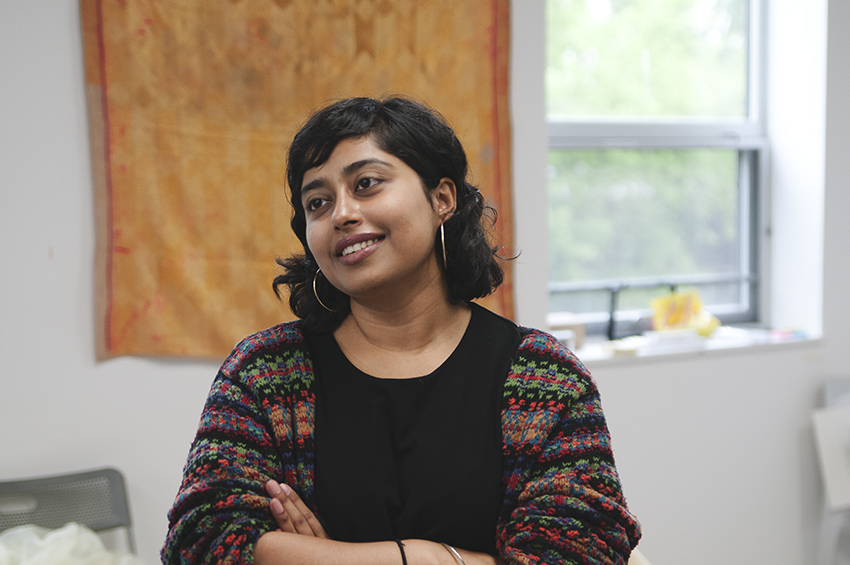
Udita uses her body as a conduit to tell the many stories that travel through it, working with textile, drawing, and performance to express narratives encountered within. Trained in Vipassana meditation, her work has a quiet patience. For her current untitled project, Udita delicately harvests gold thread woven into a collection of frayed and discarded saris, repurposing the removed material as handmade rope. Like this project, many of her works address grief, Udita teaching her hands to lose each textile they actively deconstruct.
How does your practice intersect with Vipassana meditation?
After I graduated from Boston University I returned home to Mumbai, India and among other things, I found Vipassana meditation, which is regarded as the meditation that Gautam Buddha taught. There are retreats that teach this style of meditation across the world, and it is quite rigorous. During your first retreat you don’t speak for ten days, which is amazing. You come out of the experience glowing, and your cheeks and throat just seem to relax. The practice is about checking in to your body, finding and feeling where your body houses emotions, stories, and trauma, and then staying there, within your body, and witnessing these stories and letting them change it.
Initially I didn’t know how meditation was affecting my practice, but as I stuck with it, it started to really ground me in my body. This is how I found performance art. I was able to stay with my physical body, and could finally hear the stories that it wanted to tell, which weren’t necessarily things that had happened directly within my own life, but definitely the stories that moved me. What I now practice is a mix of psychosomatic healing and Vipassana meditation, which remains a key process in all of my art making.
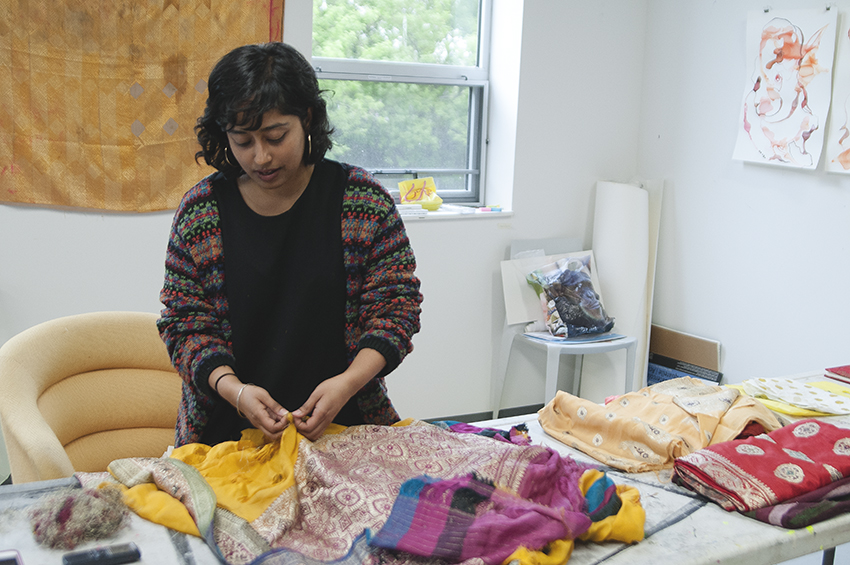
What other stories were discovered through your investigation into meditation?
In 2011 (during my MBA), I worked as a social worker in New Delhi, on G.B. Road, which is one of the largest red light districts in the world. It was a strange experience as a woman to go into a red light district and be able to come back out safe. Every time my coworker and I (who were both 24-year-old women) would enter into this space, we realized there was a possibility that we would never return. I would listen to the lived experiences of the women I worked with, and started to hear many stories of shame. I began to focus on the internalization of the shame I was hearing from these women, and then started to tap into that in my own life. My experience was much different, but still parallel. Shame is omnipresent, and yet hides in the shadows, and secrecy only fosters it. My experience with shame relative to the stories of the sex workers was banal, everyday, and perhaps too simple. Yet it was still rather difficult to overcome. It involved the shame of desire and longing, the shame of female sexuality, the shame of rejection, and the shame of failure. The stories of shame were two fold—external stigma and the internalization of the stigma. The internalization became my access point to their stories, and how they continue to find their way into my work.
How did you integrate this experience into your practice?
Having studied film in undergrad, and worked in the industry after, I was always wondering how the lens affected the telling and retelling of stories. This was particularly on my mind when I was interviewing the women of G.B. Road, especially since the camera’s lens was never allowed into the brothels with us. A few months after, the question was still stuck with me. I bought a camera in an attempt to answer this, or at least examine the lens more closely. I was interested in a similar trapping of being indoors, absence of privacy, the ideas of the night, invisibility, and conformity. As is common in India, I still lived with my parents then. I decided to utilize this situation and between 3 and 6 am, and would perform for the camera.
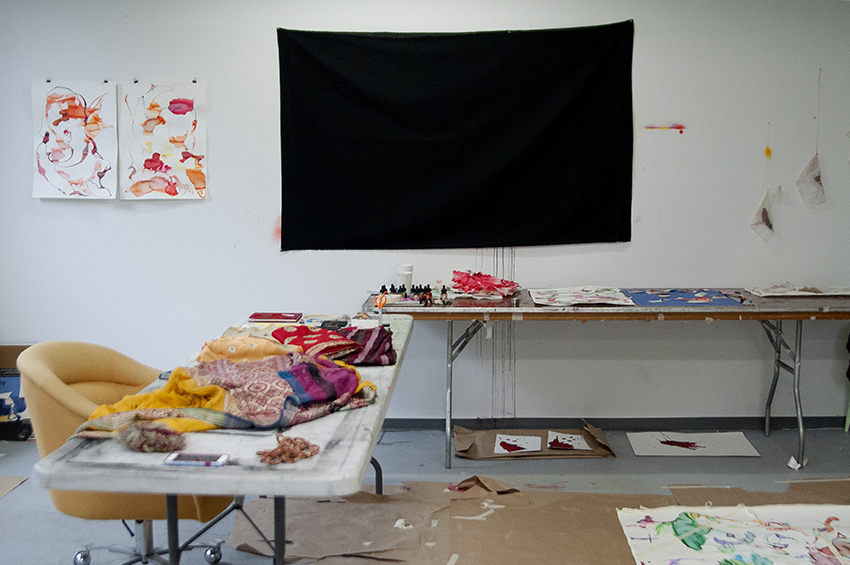
Can you describe some specific gestures you created for the camera?
I created a series of 20 performative photographs using whatever I could find in my room, from a blemished mirror to different types of lights. The gestures carried through a narrative from hiding, or rather dissolving into a curtain, to repeated silent screaming, and a host of confrontations with magnifying glasses, mirrors, and other reflective materials. Because of my background in film, I would continuously ask myself if I needed more than one frame to tell the story, and at this point in my practice I did not. The series was about conformity, but also about trying to step out of it. As much as I like to think that it was inspired by all of the stories of others I had encountered, the work was also autobiographical, a sudden but unsurprising finding of the shame and trauma that my body had housed. So, it made sense then that I needed to perform them in my body to move through them. At the beginning, this series was only seen by the graduate schools I applied to, including SAIC’s performance department. No one else had seen the work, or given access to it, which made the series even more about the invisibility and intangibility of conformity which I was dealing with both personally and socially.
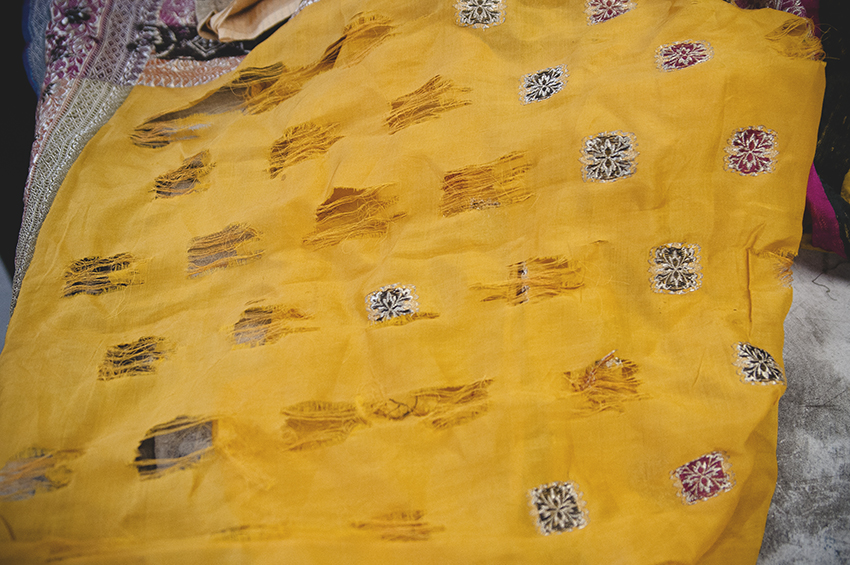
How does your practice express loss through tangibility?
I created a work titled “You Give Me Your Spine” in which I collaborated with a vintage handmade quilt. I granted myself the permission to destroy something that I couldn’t actually have constructed in the same way. Once I had this permission, I realized that I had a desire to take things apart. I am really interested in loss, or navigating loss by losing. I think a lot of the unmaking in my practice is from an interest in how to materialize a loss. What does it feel like to teach your hands to lose something?
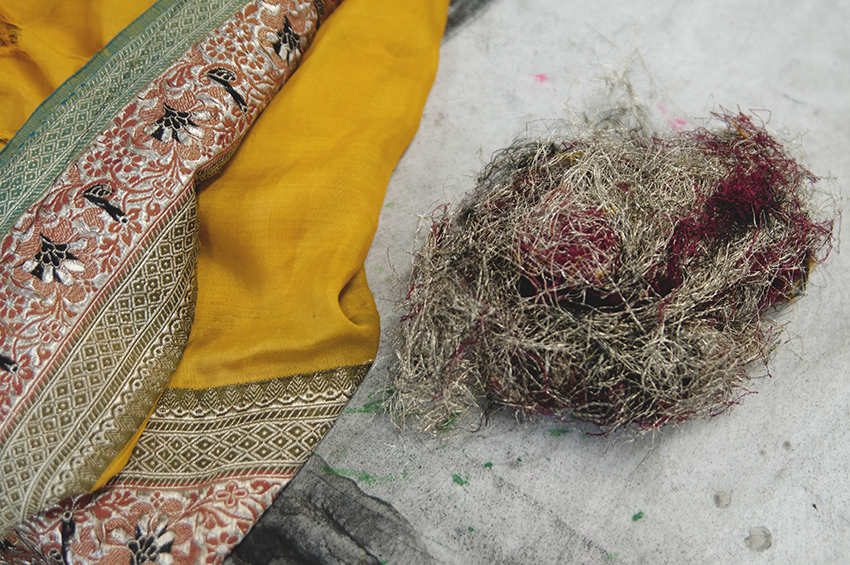
How did that project inspire your current project where you are removing the gold thread from used saris?
The leftover thread of You Give Me Your Spine started to look like language to me, which inspired the current project I am working on, which is untitled thus far. I went home last year, and was on the hunt for old, fraying fabric. It was really hard to get second hand things because there is so much need in India, and there is several layers of reuse. I eventually found five saris that are in different stages of destruction. Now, in the first part of this project, I am meticulously removing the gold thread from their brocades. This is also a material I don’t know how to make, so that becomes an interesting class and privilege conversation within the project. It is an extremely meditative process for me to remove the thread. The act of deconstructing the saris is also linked to grief, because of the destruction or this act of harvesting the gold itself, but also because I was doing this a lot when my grandfather was really sick. It took me awhile to come back to it because he passed away in January and that is when I was at home first working on this project. While I don’t know how to create this intricate weave, my hands now have a muscle memory that understands deeply the structure of this brocade. My hands know intimately what language this weave speaks, so the act of destroying is suddenly similar to the act of weaving itself which is interesting.
I think a lot of the unmaking in my practice is from an interest in how to materialize a loss. What does it feel like to teach your hands to lose something?
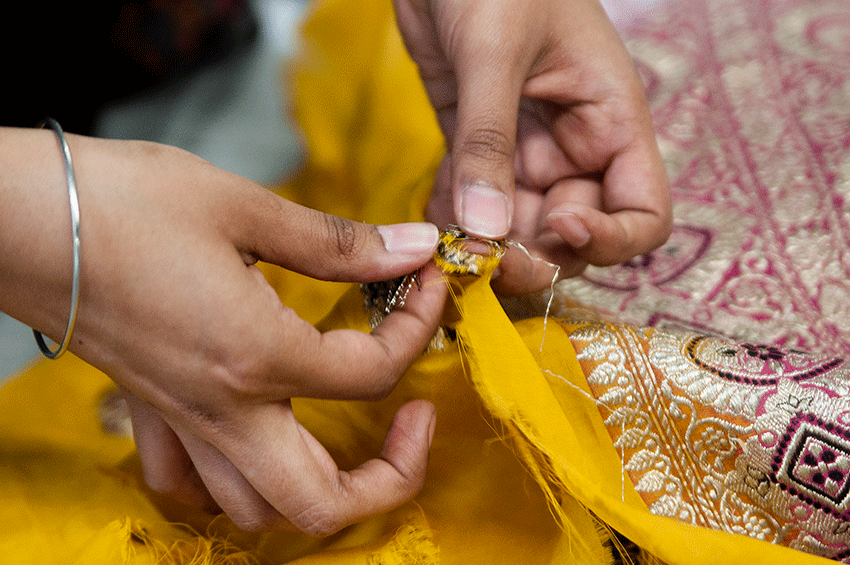
What was your initial interest in the removal of the gold thread from the found saris?
I think to me it is a bit of getting to the root of the material, someone once called it harvesting the gold, and I think I am happy to take that on—a dialogue with and recovery of ancestral material. After I remove the thread, I take three strands and start to make them into rope. After they are twisted together, I will add them into a black fabric. For the project, I was thinking about what the women in my family make, because we aren’t tied to the textile arts anymore, which is kind of a privilege to have moved up in class.
The women in my family have all been writers, and have all been thinkers in that sense. I wanted to interact with the history of the women before me that I don’t remember. The project is becoming a lot about literacy and access. There is this Hindi saying that basically means “The black alphabet might as well be the buffalo.” It is sort of like an insult, because it basically means the person you are referring to is illiterate. This saying is often on my mind because of how the access to education is a privilege that few have, and in turn the space for language, and voice is similar too. To me this project is dealing with a loss of language, but also an acknowledgement that we aren’t all given access to the same resources.
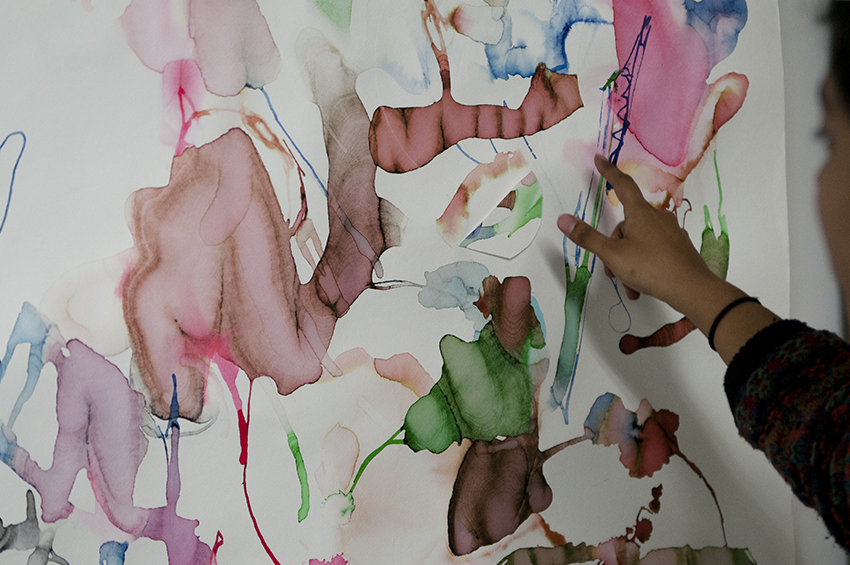
Can you describe the motivation behind the ink drawings you are making simultaneously in your studio?
The ink drawings came from a very unclear, and stressful present moment for me, and those around me. They were inspired by everything that was making me angry and frustrated starting in November, and intensifying in January. For a period I wasn’t able to be in the studio very often, so I needed to make something that could continue to work without me. I want to embrace the accidents that occur while collaborating with gravity. I read about this Buddhist idea when I first started to practice Vipassana meditation called “Abandon Hope,” and it completely threw me open. I couldn’t wrap my head around it, and I am not sure I still can entirely. But in the period of intense heartbreak, and in the thick of uncertainty, I think it was one of the things that has been fueling this project. I started to look for invisible yet sturdy forces I could rely on instead of hope, and I found a need for grounding and gravity. Working directly on the floor I create large pools of water and ink. These drawings are collaborations with gravity. I am still playing with them and trying to figure out what they are saying. I am asking gravity to let me into a grounded state, so to speak.
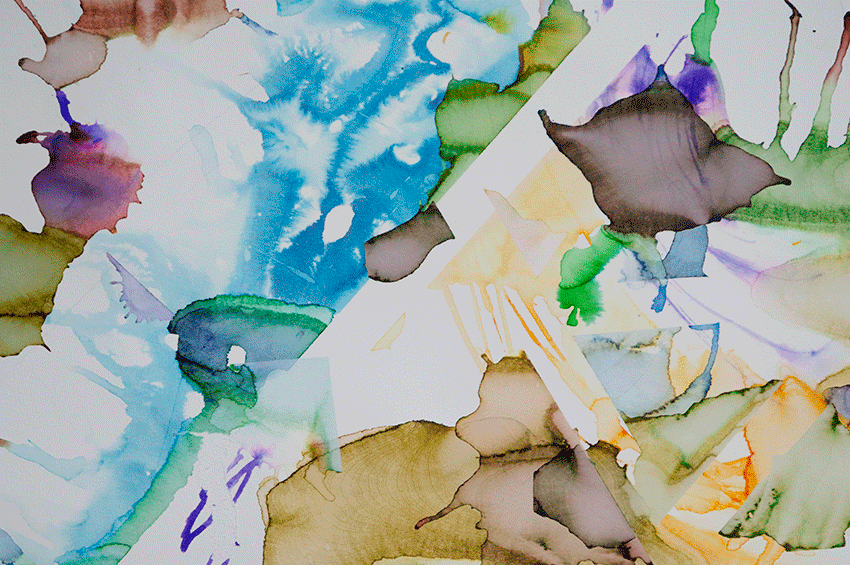
In what ways are you continuing to perform in your current practice? What are you doing with your body outside of the studio?
What I am most excited about right now is a collaborative performance work, “We Are A Lighthouse,” which is currently being workshopped through the Set Free Residency at Links Hall and will premiere the last weekend in August. Collaboration is a huge part of my process, from working with old fraying fabrics, to engaging gravity and more often with other artistic humans. I find it greatly fulfilling to work with others. It is an integral part of my work, and a great tactic to expand and deepen my practice.
We Are A Lighthouse is a performance that interweaves image, text, movement and sound. The work is directed by friend and frequent collaborator Lindsey Barlag Thornton, and Corey Smith and I are assistant directing with a focus on sound and dramaturgy respectively. We have been in residency at Links since February 2017, and June 26th is our last works in progress showing. The process of making the work has been highly collaborative with an ensemble of eight interdisciplinary artists responding to artistic prompts we curate. One of the prompts we have been playing with is “What is a missed connection you wish someone wrote about you?” Lindsey, Corey and I then further experiment and play with the material the ensemble creates, shaping and developing it into what will be a seventy-five minute live performance. The piece is becoming quite funny and poignant. We are interested in what it means to be alive, to be lonely, to be loved. There are a lot of both absurd and tender moments in the piece.


